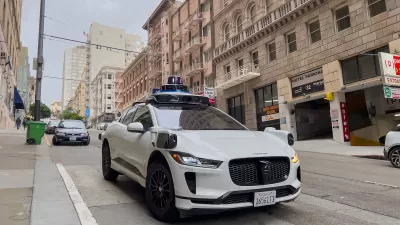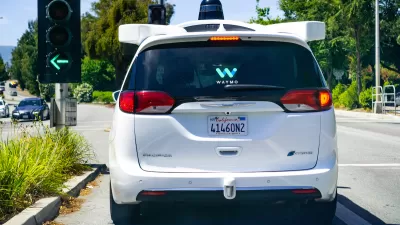In cities across the United States, robotaxis, championed by companies like Waymo and Cruise, are a marvel of modern technology and a flashpoint for debate over their place in urban transit.

“Robotaxis appeared with promises of safety, accessibility, and environmental benefits. The appeal is clear: driverless taxis eliminate the need for human drivers, theoretically reducing human error in accidents and lowering transportation costs for the public.” But as an article in Cities of the Future explains and Planetizen has chronicled, their impact on the rest of the transportation system and urban infrastructure becomes more evident.
Waymo, for example, touts its extensive safety protocols, with each vehicle equipped with a suite of sensors, including lidar, radar, and cameras that can operate with higher precision than human vision. Early data seems to indicate that, in controlled environments, robotaxis have lower accident rates than human-driven cars, but high-profile crashes involving autonomous cars have created an atmosphere of mistrust.
“The rollout could have been smoother. Cities like San Francisco have already seen issues with these vehicles interacting poorly with emergency services and blocking public transit lanes, causing frustration among officials and residents. Incidents in which AVs halt suddenly in traffic or interfere with emergency responders highlight concerns about their readiness for the unpredictable nature of urban driving. In response, some residents have attempted to disable AVs by placing traffic cones on their hoods, expressing a belief that these vehicles may worsen, rather than improve, traffic congestion and public safety.”
FULL STORY: Robotaxis Wreak Havoc on Urban Transit

Study: Maui’s Plan to Convert Vacation Rentals to Long-Term Housing Could Cause Nearly $1 Billion Economic Loss
The plan would reduce visitor accommodation by 25,% resulting in 1,900 jobs lost.

Alabama: Trump Terminates Settlements for Black Communities Harmed By Raw Sewage
Trump deemed the landmark civil rights agreement “illegal DEI and environmental justice policy.”

North Texas Transit Leaders Tout Benefits of TOD for Growing Region
At a summit focused on transit-oriented development, policymakers discussed how North Texas’ expanded light rail system can serve as a tool for economic growth.

Paris Bike Boom Leads to Steep Drop in Air Pollution
The French city’s air quality has improved dramatically in the past 20 years, coinciding with a growth in cycling.

Why Housing Costs More to Build in California Than in Texas
Hard costs like labor and materials combined with ‘soft’ costs such as permitting make building in the San Francisco Bay Area almost three times as costly as in Texas cities.

San Diego County Sees a Rise in Urban Coyotes
San Diego County experiences a rise in urban coyotes, as sightings become prevalent throughout its urban neighbourhoods and surrounding areas.
Urban Design for Planners 1: Software Tools
This six-course series explores essential urban design concepts using open source software and equips planners with the tools they need to participate fully in the urban design process.
Planning for Universal Design
Learn the tools for implementing Universal Design in planning regulations.
Smith Gee Studio
Alamo Area Metropolitan Planning Organization
City of Santa Clarita
Institute for Housing and Urban Development Studies (IHS)
City of Grandview
Harvard GSD Executive Education
Toledo-Lucas County Plan Commissions
Salt Lake City
NYU Wagner Graduate School of Public Service





























